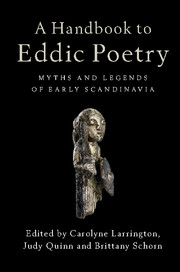Book contents
- Frontmatter
- Contents
- List of illustrations
- List of contributors
- Translations and abbreviations of the titles of eddic poems
- Introduction
- 1 The transmission and preservation of eddic poetry
- 2 Traditions of eddic scholarship
- 3 The editing of eddic poetry
- 4 The dating of eddic poetry
- 5 Eddic performance and eddic audiences
- 6 Eddic poetry and mythology
- 7 Eddic poetry and the religion of pre-Christian Scandinavia
- 8 Eddic poetry and heroic legend
- 9 Place names in eddic poetry
- 10 Eddic poetry and the imagery of stone monuments
- 11 Eddic poetry and archaeology
- 12 Eddic modes and genres
- 13 Eddic metres
- 14 Eddic style
- 15 Kennings and other forms of figurative language in eddic poetry
- 16 Alliterative lexical collocations in eddic poetry
- 17 The representation of gender in eddic poetry
- 18 The reception of eddic poetry
- Consolidated bibliography
- Index
14 - Eddic style
Published online by Cambridge University Press: 05 August 2016
- Frontmatter
- Contents
- List of illustrations
- List of contributors
- Translations and abbreviations of the titles of eddic poems
- Introduction
- 1 The transmission and preservation of eddic poetry
- 2 Traditions of eddic scholarship
- 3 The editing of eddic poetry
- 4 The dating of eddic poetry
- 5 Eddic performance and eddic audiences
- 6 Eddic poetry and mythology
- 7 Eddic poetry and the religion of pre-Christian Scandinavia
- 8 Eddic poetry and heroic legend
- 9 Place names in eddic poetry
- 10 Eddic poetry and the imagery of stone monuments
- 11 Eddic poetry and archaeology
- 12 Eddic modes and genres
- 13 Eddic metres
- 14 Eddic style
- 15 Kennings and other forms of figurative language in eddic poetry
- 16 Alliterative lexical collocations in eddic poetry
- 17 The representation of gender in eddic poetry
- 18 The reception of eddic poetry
- Consolidated bibliography
- Index
Summary
The style of eddic poetry is as distinct as its subject matter, with characteristics that go hand in hand with its unique form. This Scandinavian reflex of traditional Germanic alliterative verse was highly innovative and productive for half a millennium, spanning and responding to profound cultural change whilst maintaining the essence of the ancient character that constituted a large part of its allure for medieval redactors. The voices of ancient heroes and supernatural beings had a particular style that lent them authenticity and commanded the rapt attention that the seeress calls for at the opening of Vǫluspá (1/1–3), which begins the Codex Regius eddic collection. The ways in which eddic poets exercised their skill and originality in this tradition distanced them from courtly skaldic compositions (see Schorn on genre, Chapter 12 in this Handbook). Masters of traditional aspects of form, structure, diction, and rhetoric, individual eddic poets manipulated the poetic idioms in which they worked with varied and sophisticated effect and were thus able to draw out ever new meaning from ancient lore. The tools they used to do so are the primary focus of this chapter: diction, verse-form, and, above all, dramatic dialogues used mimetically to recreate crucial moments and encounters, allowing the characters themselves to debate their choices and motivations, their wisdom and world-views, and to argue for the meaning of their lives and legacies.
Diction
Eddic style shows the development of tendencies already present in Old English, Old Saxon, and Old High German poetry, such as the extensive use of dialogue and an aesthetic that favours allusion and economy of phrase. Old Norse likewise possesses an expansive poetic lexicon, employing a range of vocabulary that is rarely or never attested in prose, and which is in some cases likely quite archaic. Using a variety of terminology with subtle variations in meaning to reference the same object – sometimes in quick succession – allowed poets to explore aspects of its identity or role in context. Thus, the mysterious and contradictory nature of Vǫlundr's elusive wife in Vǫlundarkviða emerges as she is named mær (‘girl’), alvitr (‘strange creature’), drós (‘woman’), ljóss (‘shining [one]’), and brúðr (‘bride’) (Vkv 1, 2 3, 5, and 19).
- Type
- Chapter
- Information
- A Handbook to Eddic PoetryMyths and Legends of Early Scandinavia, pp. 271 - 287Publisher: Cambridge University PressPrint publication year: 2016
- 5
- Cited by



